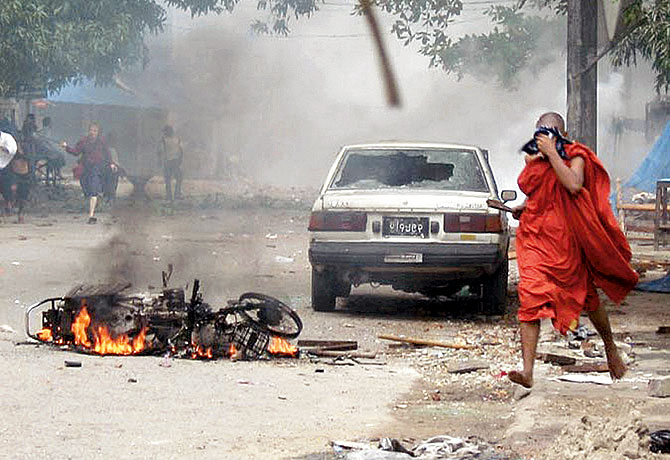British Official White Paper
He was the judge in Rangoon, eyewitness to the riots, who wrote his book based on the British Official White Paper given by The Simon Commission (The Royal Statutory Commission, appointed according to the Law of the Government of India 1919, The Montague-Chelmsford Law.)[19]
Anti-Indian and anti-Muslim sentiments started during British rule
Anti-Indian sentiments started after the First World War during the British rule.[20] In Burma there were a half million Muslims in 1921. More than half of Indians were Indian Muslims.[21]
Although Burma Muslims are different from Indian Muslims and Indian
Burma Muslims, Burmese Buddhists put them together, even with Hindu
Indians, and called them Kala.[19]
- Earlier Muslim persecution of Buddhists and Hindus during the Mughal wars of conquest, where many Buddhists and Hindus were forcibly converted.
- Low standard of living of the recent migrants.
- Recent migrants' willingness to do, dirty, difficult and dangerous jobs.
- Indians took over the Burmese lands especially Chittiers.
- Indians had already filled up and monopolized the government services when the Burmese were later ready for those jobs.
- Professional competition.
- World economic recession of 1930 aggravated the competition for the reduced economic pie.
1930 Anti-Indian riots
In 1930 there were anti-Indian riots in Burma under British rule.
The problem started in Yangon port, because of the irresponsible action of a British firm of stevedores
which had employed hundreds of Indian labourers. While those Indians
were on strike, that firm had employed the Burmese workers just to break
the strike. So the Indians had to give in and ended the strike. Next
morning when the Burmese workers came and reported for work they were
told by the British firm that their service was no longer needed. Some
Burmese workers were angry and started the fight and Indians retaliated.
It grew rapidly into an anti-Indian (including anti-Muslim) riot. Even
within the first half-hour at least two hundred Indians were massacred
and flung into the river. Authorities ordered the police to fire upon
any assembly of five or more who refused to lay down their arms, under
Section 144 of the Criminal Procedure Code. That was a black day of 26
May. Within two days the riot spread to the whole country and no one
knew the exact causality.[19]
1938 Anti-Muslim riots
There was an anti-Muslim riot in 1938, while Burma was still under
British rule. The real agenda was aimed at British government but the
Burmese dare not show this openly. Growing Nationalistic sentiments were
fanned by the local media and disguised as anti-Muslim to avoid early
detection and notice. It was followed by the full blown force of the
mighty British Government machinery. Throughout the Burmese struggles
against British rule, all the political issues, movements, meetings,
demonstrations, riots, rebellions and even the revolutions were
instigated, inspired, influenced and led by newspapers.[23][24]
Burma for Burmese Only Campaign
The Burmese started the Burma for Burmese only Campaign and marched to the Muslim (Surti) Bazaar.[25]
While the Indian Police broke the violent demonstration, three monks
were hurt. Burmese newspapers use the pictures of Indian police
attacking the Buddhist monks to further incite the spread of riots.[26]
Muslim properties: shops, houses and mosques were looted, destroyed and
burned. They assaulted and even massacred the Muslims. It spread all
over Burma and a recorded 113 mosques were damaged.[27]
The Inquiry Committee by the British
On September 22, 1938, the British Governor set up the Inquiry Committee.[28]
They found out that the real cause was the discontent in the government
regarding the deterioration in sociopolitical and economic conditions
of Burmans.[29] The book was used as an inciting factor by the irresponsible Burmese newspapers.[30]
The Simon Commission (The Royal Statutory Commission, appointed
according to the Law of the Government of India in 1919, The
Montague-Chelmsford Law) an inquiry of the effects of Dyarchy system of
ruling Burma, had recommended that special places be assigned to the
Burma Muslims in the Legislative Council.
It recommended that full rights of citizenship should be guaranteed
to all minorities: the right of free worship, the right to follow their
own customs, the right to own property and to receive a share of the
public revenues for the maintenance of their own educational and
charitable institutions. It recommended Home Rule or independent
government separate from India or the status of dominion.
But the British Government did not accept all these recommendations
except for separation, at the round table committee on India held in
London in 1930.
